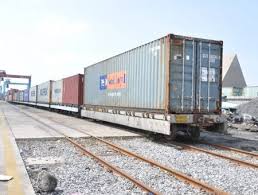By Richards Adeniyi
The Nigerian Shippers’ Council (NSC) on Monday assured Nigerians that it would supervise the Standard Operating Procedure (SOP) of cargo evacuation between the Nigerian Railway Corporation (NRC) and the APM Terminal, in order to ensure efficiency.
The Council’s Director, Regulatory Services, Mrs Ifeoma Ezedinma stated this at the resumed evacuation of cargoes by rail in Lagos.
She also stressed, that to ensure things move smoothly, the NRC and the APM Terminal would have to adhere to the SOP.
“There are many challenges in the port right now due to the shutdown which has resulted to congestion, but with this reintroduction of evacuation by rail, we believe it will go a long way in the port decongestion.
“The rail evacuation will reduce cost, the economy of demand and supply will also come to play as it will give room for our exports which are languishing on the road to gain access to the port,” she said.
Mr Jerry Oche, Railway District Manager, NRC, Lagos said that the new agreement for the evacuation of cargoes would work because of the SOP was binding on everyone and the shippers’ council was standing as the supervisor.
“We have been on this for quite sometime, but the difference today is that we are starting with an SOP; in the past, all we were doing was that everyone was doing his or her own thing.
“Now we have an SOP binding on everyone and we have a shippers council as a supervisor; yes, we have done it in the past and I tell you this will work because this is different,” he said.
The district manager said that a train was made up of 19 wagons and each of the wagons could take 40ft or 20ft containers.
According to him, if they are doing 40ft it means 19 trucks off the road and if it is 20ft, that would take 38 trucks off the road.
Oche said that APMT had urged them to do four trips but they were starting with two.
”We want to start small and increase, but we believe we can do more than four trips,” he said.
Oche said that adopting the standard gauge would improve their operation, and when the standard gauge comes, the SOP would be on auto pilot, a seamless operation driving itself.
The External Affairs Manager, APM terminals, Daniel Odibe, said the new SOP would help bridge the communication gap that they had experienced with NRC in the past.
“This is an important milestone being achieved here, and it is something we have always asked for, an SOP for receiving trains into the terminal and servicing them.
“It will definitely help in planning, bridge communication gap that we have experienced with NRC in the past and lead to more efficient operation with more cargo being handled through the rail tracks,” he said.
Odibe commended the Shippers’ Council for bringing together the NRC and APM terminals to bridge that communication gap.
“Right now, we have an SOP that will enable us to receive the right containers coming to APMT without any hindrance and also enable us to service the trains within the agreed timelines.
“We do not envisage more challenges with the commencement of the SOP and it will also create a platform for us to meet, review the past and seek ways to improve.
“What we proposed was for four trains in a day within every 12 hours but NRC advised we start with two and scale up as we go, assuring us that the process would be sustained,” he said.
Odiba said that their intention when they constructed the rail line in 2013 and connected it to the national line was to provide an alternate mode of evacuation of cargoes to customers.
He said that the day’s event would increase the number of containers evacuated through the rail line, as it was coming at the best time, when the bridge was closed for repairs.

 Latest4 days ago
Latest4 days ago
 Latest2 days ago
Latest2 days ago
 News1 day ago
News1 day ago
 Latest3 days ago
Latest3 days ago
 Energy5 days ago
Energy5 days ago
 Business5 days ago
Business5 days ago
 Comments and Issues5 days ago
Comments and Issues5 days ago
 Business5 days ago
Business5 days ago

